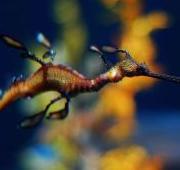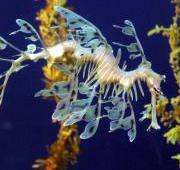 The sea dragon is a small, delicate fish found in the tropical coastal waters of south and west Australia. Sea dragons look similar to and are in fact closely related to sea horses.
The sea dragon is a small, delicate fish found in the tropical coastal waters of south and west Australia. Sea dragons look similar to and are in fact closely related to sea horses. There are two different species of sea dragon which are the leafy sea dragon and the weedy sea dragon. Although both sea dragon species have a similar body shape and size, they are very different in appearance.
There are two different species of sea dragon which are the leafy sea dragon and the weedy sea dragon. Although both sea dragon species have a similar body shape and size, they are very different in appearance.


Despite their small size, sea dragons are carnivorous animals and therefore have a purely meat-based diet. The sea dragon uses its pipe-like snout to suck its prey into its oddly tooth-less mouth. Sea dragons hunt crustaceans, plankton, shrimp and even small fish, using their camouflage to their advantage.
Sea dragons have numerous natural predators in the south and western coastal waters of Australia but are rarely even spotted to the elaborate camouflage of the sea dragon. Those few sea dragons that are unlucky enough to be found, are usually spotted by large fish.
As with sea horses, it is the male sea dragon who care for the eggs once they have been laid by the female. The female lays around 250 eggs onto the long tail onto the long tail of the male sea horse. The eggs of the sea dragon can take up to 9 weeks to hatch and remain in the care of the male sea dragon at all times.
The baby sea dragons are completely independent once they have hatched and feed on tiny nutritious particles in the water. It can take up to a year for the sea dragon babies to be nearly the size of the adult sea dragons.

